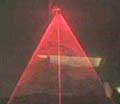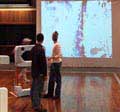Physical Computing Course
(past projects)
Increasingly we find computational capabilities embedded in our built environment. Design of computationally enhanced objects and places is an attractive and motivating activity that requires multidisciplinary learning and cooperation: it attracts artists,musicians, and architects as well as computer scientists and engineers.
This course offers students an opportunity to collaboratively explore Physical Computing while designing and building a smart / reactive environment.
This offers us the opportunity to see how a wide range of people approach the topic, lets us loosely explore topics of interest, and feeds new ideas into our research lab.
Several projects from this course are listed on our site. They are the Memory Box, Interactive Book, Laser Space, and the Alphabet Paint Space.
- web page: /courses/arch498z
- researchers: Ken Camarata
last updated 8.24.2006 by Mark D Gross
2003
A Physical Computing Studio: Exploring Computational Artifacts and Environments
- pdf
Ken Camarata, Mark D Gross, Ellen Yi-Luen Do
International Journal of Architectural Computing (IJAC) volume 1 no 2:169-190
Ken Camarata, Mark D Gross, Ellen Yi-Luen Do
International Journal of Architectural Computing (IJAC) volume 1 no 2:169-190
2003
ITR proposal: Computationally Enhanced Construction Kits and Craft
- pdf
Mark D Gross, Michael Eisenberg
Proposal to the National Science Foundation
Mark D Gross, Michael Eisenberg
Proposal to the National Science Foundation
2002
Physical Computing: A Design Studio that Bridges Art, Science, and Engineering
- pdf
Ken Camarata, Mark D Gross, Ellen Yi-Luen Do
ICLS (International Conference of the Learning Sciences)
Ken Camarata, Mark D Gross, Ellen Yi-Luen Do
ICLS (International Conference of the Learning Sciences)
2002
Computationally-Enhanced Construction Kits for Children: Prototype and Principles
- pdf
Michael Eisenberg, Ann Eisenberg, Mark D Gross, Khomkrit Kaowthumrong, Nathaniel Lee, and Will Lovett
International Conference of the Learning Sciences, Seattle WA pp 79-85
Michael Eisenberg, Ann Eisenberg, Mark D Gross, Khomkrit Kaowthumrong, Nathaniel Lee, and Will Lovett
International Conference of the Learning Sciences, Seattle WA pp 79-85





